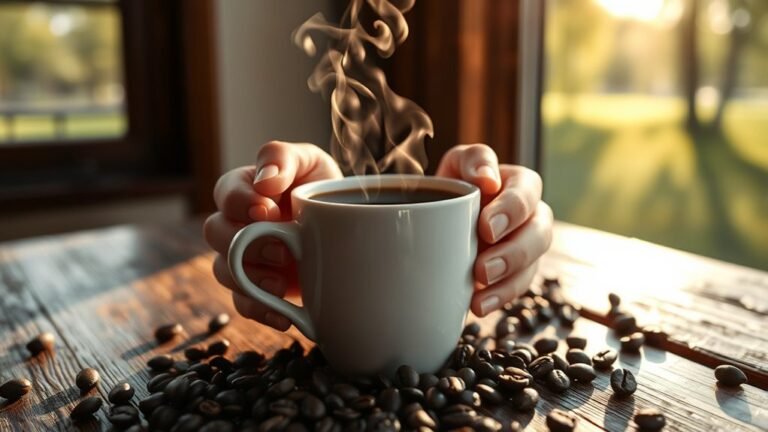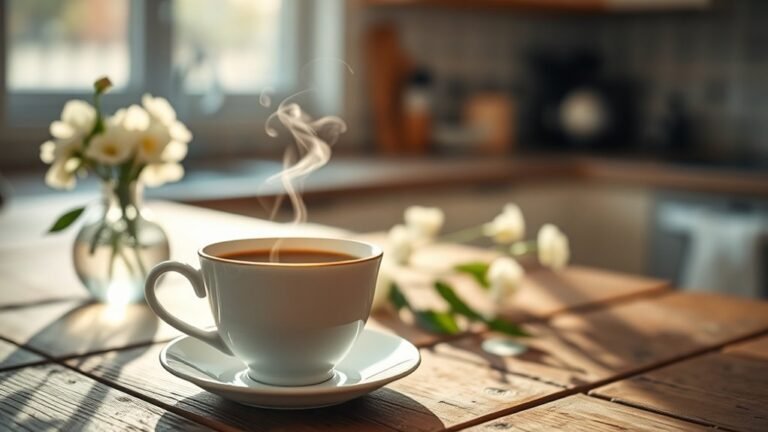Can You Use Espresso Coffee in a Filter Machine
Yes, you can use espresso coffee in a filter machine, but expect notable differences in flavor, aroma, and texture compared to traditional brewing methods. The extraction process differs, leading to a milder and potentially less intense brew. Factors like grind size, water temperature, and brew time greatly impact your results. If you’re curious about optimizing your brewing technique and achieving the best flavors from espresso in a filter machine, there’s more to explore on this topic.
Understanding Espresso Coffee and Its Characteristics
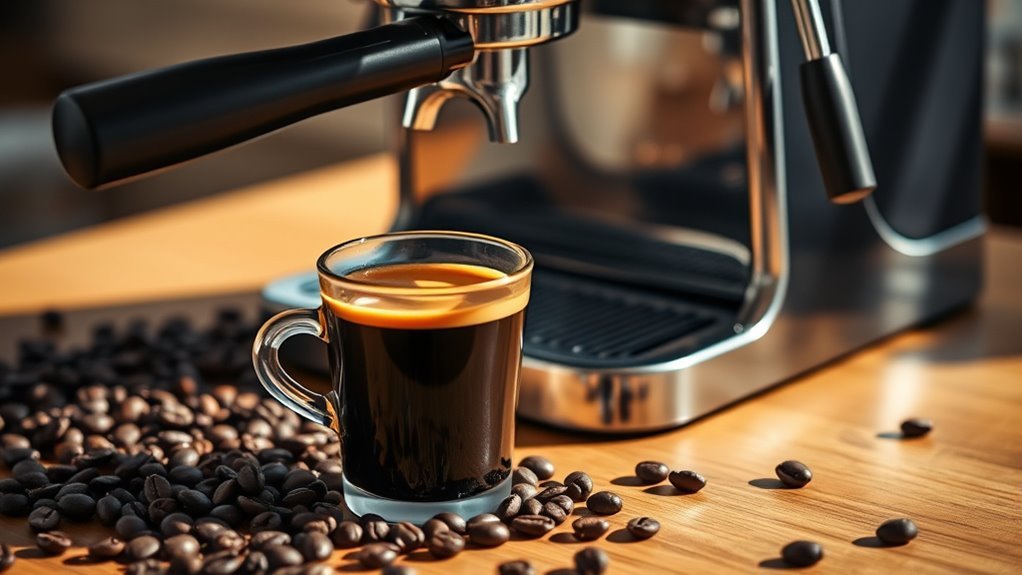
Espresso coffee is often celebrated for its rich flavor and intense aroma, distinguishing it from other brewing methods. Its origins trace back to Italy, where baristas innovated extraction techniques that use high pressure to force hot water through finely-ground coffee. This method produces a concentrated shot, highlighting the coffee’s natural oils and sugars, resulting in a complex taste profile. Unlike traditional brewing, which often emphasizes volume, espresso focuses on intensity and depth. Understanding these characteristics is essential for any coffee enthusiast. When you appreciate espresso’s unique attributes, you gain a deeper insight into why it’s not just a drink but an experience, providing the freedom to explore various flavors, aromas, and coffee origins in every cup.
How Filter Machines Work
Filter machines operate on a straightforward yet effective brewing principle that contrasts sharply with the espresso method. At their core, these machines utilize filter paper or metal screens to separate coffee grounds from liquid, ensuring a clean cup. The filter machine mechanics involve hot water steadily dripping through the coffee grounds, allowing gravity to extract flavors and aromas over a longer brewing time. This method enhances brewing efficiency, as it effectively captures the nuanced characteristics of the coffee. The result is a milder brew, rich in clarity and complexity. While it may lack the intensity of espresso, understanding filter machines helps you appreciate their unique approach to coffee extraction, offering a different kind of freedom in your brewing choices.
Differences Between Espresso and Filter Coffee
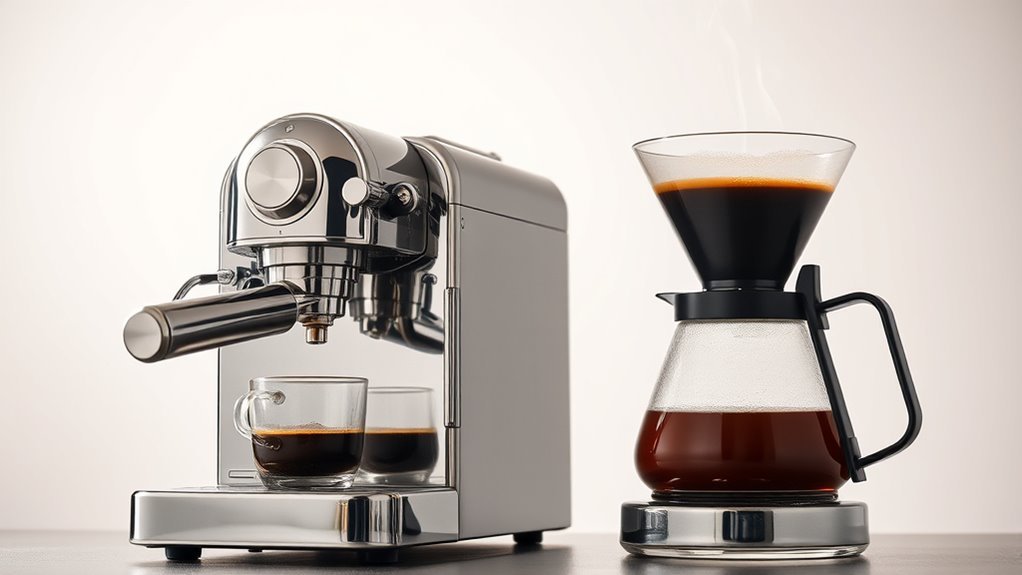
When comparing espresso and filter coffee, you’ll notice significant differences in brewing methods and grind sizes. Espresso requires a high-pressure extraction process, while filter coffee relies on gravity to draw water through coarsely ground beans. Understanding these distinctions can enhance your brewing experience and help you make the most of your coffee.
Brewing Method Variations
How do the brewing methods for espresso and filter coffee differ fundamentally? Each method employs distinct brewing techniques that considerably influence the final coffee taste. Espresso uses high pressure and finely ground coffee, extracting flavors quickly. In contrast, filter coffee relies on gravity, allowing water to flow through coarser grounds over a longer period. This difference leads to varying flavor profiles and caffeine content.
| Aspect | Espresso |
|---|---|
| Pressure | High |
| Brew Time | Short (20-30 sec) |
| Grind Size | Fine |
| Flavor Profile | Bold, intense |
Understanding these variations can enhance your coffee experience, whether you’re experimenting with espresso in a filter machine or sticking to traditional methods.
Grind Size Differences
While the grind size may seem like a minor detail, it plays an essential role in the brewing process for both espresso and filter coffee. Espresso requires a fine grind consistency, allowing for rapid extraction under pressure. This leads to a concentrated flavor and rich crema. In contrast, filter coffee benefits from a coarser grind, which promotes a slower extraction efficiency, allowing water to pass through the grounds evenly without over-extraction. If you use espresso coffee in a filter machine, the fine grind can lead to over-extraction, resulting in a bitter taste and a murky brew. Understanding these differences enables you to optimize your coffee experience, whether you prefer the boldness of espresso or the smoothness of filter coffee.
Can You Brew Espresso Coffee in a Filter Machine?
You might wonder if brewing espresso coffee in a filter machine is possible and how it affects the flavor. The differences in brewing methods considerably impact the extraction process, which can alter the taste profile of your coffee. Understanding these distinctions can help you decide whether this approach suits your preferences.
Brewing Method Differences
Although filter machines and espresso makers both brew coffee, the methods they employ create distinct differences in flavor and extraction. Here are some key aspects of their brewing techniques:
- Pressure: Espresso machines use high pressure to extract flavors quickly, while filter machines rely on gravity.
- Grind Size: Espresso requires a fine grind for peak extraction; filter coffee uses a coarser grind.
- Brew Time: Espresso brews in about 25-30 seconds, whereas filter coffee takes several minutes.
- Water Temperature: Espresso uses hotter water, around 190-205°F, while filter machines typically brew at slightly lower temperatures.
- Flavor Extraction: The methods lead to different flavor profiles, with espresso being more intense and concentrated.
Understanding these differences can help you appreciate how each method impacts your coffee experience.
Flavor Profile Impact
Brewing espresso coffee in a filter machine raises questions about flavor profile and extraction. The flavor intensity you expect from a traditional espresso shot may diminish when brewed this way. Filter machines utilize a slower extraction process, which can lead to a less concentrated taste and altered mouthfeel. While some complex flavors might emerge, the rich crema that characterizes espresso will be absent.
Aroma preservation is also compromised; the delicate scents that enhance the espresso experience may dissipate during the longer brewing time. If you’re seeking the boldness and vibrancy of espresso, a filter machine may not be the ideal choice. Ultimately, experimenting with different methods will help you find the flavor profile that suits your palate best.
Potential Flavor Profiles When Brewing Espresso in a Filter Machine
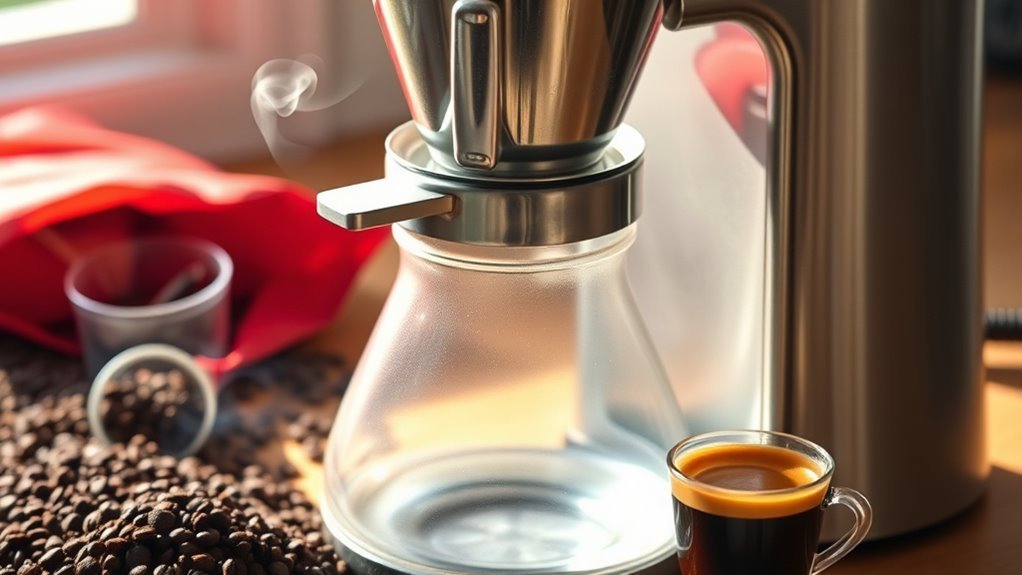
How does the method of brewing espresso in a filter machine alter its flavor profile? Brewing espresso in a filter machine can highlight different espresso notes and flavor nuances compared to traditional methods. The extraction process is slower, which can lead to:
- Milder acidity, softening the punch of bold flavors
- Enhanced sweetness, bringing out caramel or chocolate notes
- A more balanced body, losing some richness typical of espresso
- Increased bitterness, if over-extraction occurs during brewing
- Subtle floral or fruity notes, depending on the coffee beans used
Tips for Brewing Espresso Coffee in a Filter Machine
The unique flavor profiles produced when brewing espresso in a filter machine can be further refined with the right techniques. Start by selecting high-quality espresso beans; their natural oils will enhance the extraction process. Use a medium grind size to enhance coffee extraction, ensuring the water flows evenly through the grounds. Maintain a water temperature of around 195°F to 205°F for ideal brewing. Experiment with brewing techniques, like pre-wetting your coffee grounds to improve saturation and flavor. Finally, adjust your brew time to achieve the desired strength, as over-extraction can lead to bitterness. By honing these methods, you’ll reveal the full potential of espresso coffee brewed in a filter machine, allowing for a rich, satisfying cup.
Experimenting With Ratios and Brewing Times

While achieving the perfect cup of espresso coffee in a filter machine may seem straightforward, experimenting with ratios and brewing times can considerably impact the flavor and strength of your brew. To enhance your brewing techniques, consider the following:
Experimenting with coffee ratios and brewing times can significantly elevate your espresso experience, allowing for a personalized flavor profile.
- Coffee-to-water ratio: Adjust the amount of coffee to find your ideal strength.
- Brewing time: Experiment with longer or shorter brew times to see how it affects taste.
- Grind size: Vary the grind size to alter extraction rates.
- Water temperature: Test different temperatures to find the sweet spot for flavor.
- Taste testing: Regularly sample your brews to identify what works best for you.
Engaging in taste experimentation reveals the freedom to create a cup tailored to your preferences.
Frequently Asked Questions
Can I Use Espresso Ground Coffee in a French Press?
Yes, you can use espresso ground coffee in a French press, but it’s not optimal. Espresso grounds are fine and can lead to over-extraction during the brewing process, resulting in a bitter taste. For best flavor, coarser grounds are recommended. If you enjoy the boldness of espresso, try using a medium grind instead. This way, you’ll balance the extraction and enjoy a rich, flavorful cup from your French press without the bitterness.
What Grind Size Is Best for Filter Machines?
Did you know that the grind size can impact coffee extraction by up to 20%? For filter machines, a medium grind consistency is best, as it allows for ideal brewing time, typically around 4-5 minutes. Too fine a grind may lead to over-extraction, while too coarse can under-extract, resulting in a weak flavor. Achieving the right balance lets you enjoy a richer cup while giving you the freedom to explore various coffee profiles.
Will Using Espresso Coffee Affect Caffeine Content?
Using espresso coffee in a filter machine can indeed affect caffeine extraction and flavor profile. Espresso beans are typically ground finer, which may lead to over-extraction and a bitter taste when brewed in a filter. While the caffeine content remains relatively high, the brewing method influences how much you actually get in your cup. So, if you’re seeking a balanced flavor and ideal caffeine levels, sticking to the right grind for filter machines is essential.
How Does Water Temperature Impact Brewing Espresso in a Filter Machine?
Water temperature’s like a maestro conducting a symphony; it dictates the harmony of flavors during extraction. In brewing espresso with a filter machine, ideal temps—around 195°F to 205°F—enhance water extraction, ensuring oils and compounds mingle beautifully. If it’s too cold, you’ll miss out on the rich flavors, while too hot can lead to bitter notes. Striking that balance boosts brewing efficiency, allowing you to savor every drop of your coffee’s potential.
Can I Mix Espresso Coffee With Regular Coffee in a Filter Machine?
You can mix espresso coffee with regular coffee in a filter machine, but the results depend on the espresso blend and its flavor profile. Combining them can create a unique taste experience, balancing the boldness of espresso with the milder notes of regular coffee. However, be cautious about the brewing time and water temperature, as these factors can affect extraction and ultimately the flavor. Experimenting can lead to an enjoyable custom brew tailored to your preferences.

